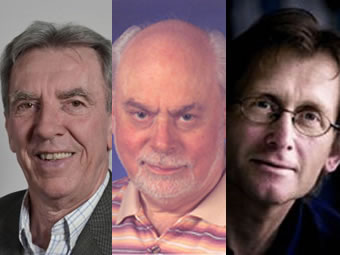(单词翻译:单击)
听力文本
This is Scientific American — 60-Second Science. I'm Steve Mirsky.
Got a minute?
"This year's Nobel Prize in Chemistry is about the world's smallest machines."
Göran Hansson, secretary general of the Royal Swedish Academy of Sciences, earlier this morning.
"The Royal Swedish Academy of Sciences has decided to award the 2016 Nobel Prize in Chemistry jointly to Jean-Pierre Sauvage, Sir James Fraser Stoddart and Bernard L. Feringa for the design and synthesis of molecular machines."
Sauvage was born in Paris and is now an emeritus professor at the University of Strasbourg. Stoddart comes from Edinborough and is now at Northwestern University in Illinois. Feringa is from the Netherlands and is at the University of Groningen.

Following the announcement, Feringa called in and explained some of the potential applications for the microscopic machines.
"First of all let me say I feel a little bit like the Wright Brothers, who were flying a hundred years ago for the first time. And then people were saying, 'You know, why do we need a flying machine?' And now we have a Boeing 747 and an Airbus. So that is a bit how I feel...but once you are able to control movement, you have a motor, you can think of all kinds of functions."
"So indeed, we think of transporters, like in your body there are many motors and machines that make it possible that your cells divide, that your muscles work, that there is transport in the cells, etc. But you can think also much broader. Think about nanomachines, microrobots, think about tiny robots that the doctor in the future will inject in your bloodstreams and that go to search for a cancer cell or are going to deliver a drug for instance. But also smart materials, for instance, materials that can adapt, change, depending on an external signal, just like our body functions. That is the kind of functions you can think of."
Thanks for the minute for Scientific American — 60-Second Science Science. I'm Steve Mirsky.
参考译文
这里是科学美国人——60秒科学。我是史蒂夫·米尔斯基。
有一分钟时间吗?
“今年的诺贝尔化学奖是关于世界上最小的机器。”
今天上午早些时候,瑞典皇家科学院秘书长约兰·汉松宣布。
“瑞典皇家科学院决定将2016年诺贝尔化学奖授予让-皮埃尔·索维奇、詹姆斯·弗雷泽·司徒塔特勋爵以及伯纳德·L·费林加,因为他们成功设计并合成了‘分子机器'”。
索维奇出生于巴黎,现在是斯特拉斯堡大学的名誉教授。司徒塔特现在在伊利诺斯州的西北大学任教。来自荷兰的费林加现在在格罗宁根大学任教。
宣布获奖者之后,费林加在现场连线时解释了这台微观机器的应用潜力。
“首先我要说,我觉得有点像莱特兄弟,他们在一百年前首次尝试了飞行。当时人们不禁发问:‘我们为什么需要飞行器呢?’但是现在我们有波音747和空客。所以,这是我现在有点这种感觉……一旦你能控制运动,你有一台发动机,那么你就可以想象各种功能。”
“我们想象一下运输工具,就像你体内的许多发动机和机器一样,它们将你的细胞分类、让你的肌肉工作,这时细胞内部就在进行运输。可以把眼界再放宽一点。想象一下,未来医生会将纳米机器人或微型机器人注入你的血液中,它们寻找癌细胞或者传送药物。还有智能材料,这种材料可以根据外部信号来适应、改变,就像我们的身体机能一样。这就是你可以想象的功能。”
谢谢大家收听科学美国人——60秒科学。我是史蒂夫·米尔斯基。
译文为可可英语翻译,未经授权请勿转载!
重点讲解
重点讲解:
1. first of all 第一;首先;
例句:First of all I must check the number.
首先我必须检查那号码。
2. be able to do sth. 可以…的,能够…的;
例句:He was able to fulfil himself through music.
他通过音乐能充分地发挥自己的才能。
3. all kinds of 各种类型的;五花八门的;
例句:All kinds of clothes are on display on the shelves.
货架上摆放着各式各样的服装。
4. depend on 取决于;根据;由…决定;
例句:I tend to have a different answer, depending on the family.
根据家庭的不同,我往往会给出不同的答案。


